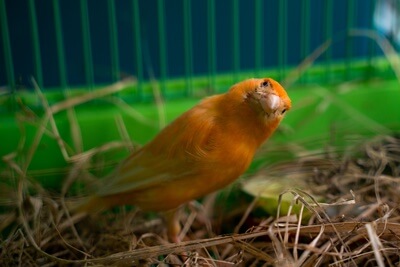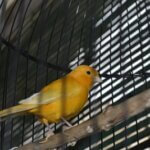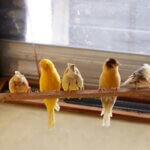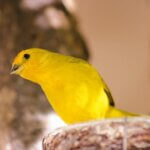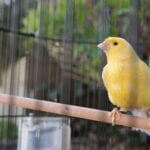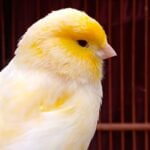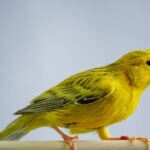Canaries rarely sit on the ground in their cage or while exploring your home. This is a vulnerable place in the wild, making it easier for predators to access them and more difficult for a canary to reach the necessary heights to escape danger when they take flight.
Instead, when they’re not flying or hopping around their cages, canaries prefer to spend most of their time perched above the ground. That makes it concerning if your canary stays on the bottom of its cage or begins sitting in the corner of its cage, as it’s unnatural behavior.
There are no positive reasons for a canary to sit on the floor of its cage, but some are more harmless than others. For example, your canary may not have enough perches to use, especially if it shares the enclosure with cage mates and has to vie for space, leaving it nowhere to rest but on the floor.
In more severe cases, it may indicate that your canary is ill, injured, or afraid.
Why Is My Canary On The Floor?
Most canaries never visit the floor of their cage except for a brief few seconds.
A canary may flutter down there to pick up fallen food, to curiously explore this part of its new cage, or to avoid a cage mate during playful fluttering.
The canary shouldn’t stay down there, especially to rest or for hours at a time. If it does, your canary may be dealing with one of these issues:
Illness
A sick canary may fall to the bottom of its cage and lack the energy to get back up.
Alternatively, it may lack the strength to stand on a perch correctly, so it’ll lose its balance and flutter to catch itself. After several failures, it may be forced to the bottom of the cage to rest.
Possible ailments can range from infections (viral, bacterial, or fungal), to respiratory issues, to severe diseases like avian pox.
The shared symptom is the canary won’t feel well enough to stay or rest high up in the cage.
Frailty Caused by Aging
The average canary has a life expectancy of 10-15 years. Some live even longer, depending on genetics, care, and diet. Unfortunately, even the healthiest canary will experience the natural process of aging, which can have symptoms such as:
- Fatigue
- Lacking balance
- Loss of muscle control
As with sickness, these factors can lead to your canary struggling to perch or unable to fly correctly from one place to the next. So, it may end up on the floor due to a fall and be unable to fly back up, or it may settle for resting on the floor after it exhausts itself with a lack of coordination.
Ataxia
Ataxia is a condition that affects the musculoskeletal and nervous systems.
It’s mostly caused by injury to the nerves or the spinal cord. Canaries affected by this condition can’t control their voluntary muscles, including those in their limbs.
As a result, they can’t control their legs’ positioning and movements, which can cause them to walk clumsily and fall often. If your canary has ataxia, it’ll also struggle to stay perched, leaving no choice but to spend most of its time sitting on the ground or lying down.
Ataxia is a serious condition that may cause permanent disability if not diagnosed and treated early. So, if your canary manifests signs of uncoordinated movement and seems unable to walk or hop without falling, have it examined by a vet.
Fear of New Environment
As prey animals, canaries have evolved to be alert about sudden environmental changes. This hyper-vigilance allows the canary to recognize potential threats and respond to them quickly.
Although it’s unnecessary for pet canaries, the instinct remains. A newly bought canary or an existing pet that’s been moved to a new home may be anxious and wary about the new environment, and it could then respond by huddling at the bottom of its cage.
This is more likely if there are no decorations in the cage that the bird can use to hide. The same is true if the cage is exposed on all sides of the upper part is barer than the floor. This is part of why canaries are so difficult to breed; they enjoy their privacy and don’t react well to being visible from every angle.
In these situations, your canary may decide the bottom of the cage is the safest place to hide. Perhaps there is plastic trim around the cage’s base, or newspaper or bowls lie there. The canary will view these as ways to break the line of sight and prefer to stay there until it feels comfortable again.
Some canaries will overcome this fear with time and be drawn back up to the perches high in the cage. Others will only become more stressed until one-half of the cage is placed against the wall (even better if two sides are) or decorations are added.
Fatigue
Canaries are active birds that spend most of their waking hours flying around their cage, hopping between perches, and exploring their environment.
These activities require lots of energy. The healthy canary recoups by drinking water and resting on a perch. If the canary exerts itself more than normal, it might rest at the bottom of the cage.
This is more common if the canary is ill, mating, frightened, molting, or malnourished. For example, a rehomed canary that was poorly fed before will take a while to build its energy reserves again, and exercising during this time may leave it unnaturally fatigued.
Likewise, a canary frightened by a loud noise or pet and then panicked for several minutes will be more tired than normal. Molting is an exhausting process, and canaries that exercise during this time may decide to rest wherever they can to catch their breath, the floor included.
A heavy breeding season can also lead to abnormal fatigue. A male with several rivals to warn off and many females to impress might exert himself too much. According to Animal Behaviour, even the seemingly effortless act of singing expends a considerable amount of energy.
So, if your canary rests on the floor in these situations, you don’t need to panic immediately. The bird should catch its breath and return to normal in a couple of minutes.
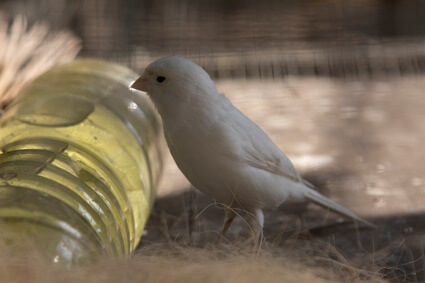
Attempts To Escape
If your canary feels scared, bored, or too confined within its cage, it might try to squeeze through the bars at the bottom of the cage to escape.
What appears to be mild-mannered sitting could be the canary sizing up the enclosure’s bars or taking a break after trying to squeeze through.
If the cage bars have spacing no greater than ½ inch, your canary cannot escape. That doesn’t mean you should ignore its efforts. A trapped canary that wants to be free will begin to manifest behavioral problems if left unattended. This may include:
- Adding toys to the cage.
- Providing a more balanced diet.
- Singing with your canary or playing music.
- Providing a larger cage.
- Limiting access that other pets have to the room where your canary lives.
Laying Eggs
It’s not uncommon for female canaries to lay eggs on the ground, especially if they’re inexperienced at building nests and brooding. First-time mothers will choose whatever place is flat and secluded, which may be the cage floor.
This also occurs when a female enters the condition and wants to lay eggs, but no nesting box is present. You may be trying to discourage egg-laying or didn’t prepare because no male is present. Even without a male, female canaries can lay eggs.
You’ll know this is the reason if your sexually mature female canary is crouching at the bottom of its cage. Eggs may come shortly after, or the female may be sizing up the area as a potential nest in advance.
Not Enough Perches
If you own several canaries in a tiny cage with few perches, some will inevitably sit on the ground to sleep or rest. The issue is a lack of space, and your canaries have no choice. Adding more perches, buying a larger cage, or separating the canaries into different enclosures should help.
However, consider these birds’ solitary and territorial nature if you have enough space and perches.
Some canaries will fight to defend and claim any available perches, forcing the others onto the ground. This may include one aggressive canary driving off the others or a couple of them vying for dominance against the others.
Crowding your canaries in a single cage is likely to cause frequent bullying and competition for food, water, toys, and mating partners. This can stress out the entire flock, so if this behavior appears, give each canary its enclosure.
At the least, avoid pairing two sexually mature males together. According to the University of Maryland, adult male canaries produce a lot of testosterone, which promotes high aggression targeted toward perceived competitors.
Feeling Cold
Canaries deal with heat far better than cold. They can tolerate up to 100 degrees Fahrenheit without becoming sick as long as they have shade and water—conversely, anything below 50 degrees Fahrenheit can induce shivering and intense discomfort.
Although canaries have been shown to survive temperatures down to the 30-degree mark, this is dangerous to their health. At the very least, they can become exhausted from the energy burned to maintain their internal heat.
When a canary is too cold, it puffs its feathers and hunkers down to conserve warmth. If the perches are too exposed, the canary may go to the floor to huddle against a decoration or cage trim.
In severe cases, your bird may be so cold that it’s unable to perch correctly, forcing it to settle on the floor instead. This happens when its feet become too chilled to grip properly or lack the energy to hold themselves onto the perch.
Hunger
Like age, sickness, and fatigue, your canary may sit at the bottom of the cage because it’s extremely hungry. Even in the early stages, starvation will leech the energy out of your canary and weaken it.
Due to their fast-paced metabolism, canaries need regular meals throughout the day and can’t function without a steady supply of calories.
If your canary has run out of food for more than a few hours, it may be compelled to sit on the cage floor because it lacks the energy to do anything else. Technically, canaries can survive 2-3 days without food, but this is risky, as some are known to die on the first day.
Malnourished or frail canaries are at the greatest risk, and they may succumb to lying down on the cage floor earlier than others.
Stroke
Although rare, canaries can suffer from a stroke like other creatures. If they do, they’ll lose control over their body and may fall onto the ground. Once at the bottom of the cage, they may be too weak or disoriented to get up again. Strokes in a bird may be caused by the following:
- Old age
- Bad diet
- Severe heat exposure
- Sleep deprivation
- Disease
The most common type of stroke for a bird is cerebral stroke, which will cause partial or complete paralysis. When this occurs, your pet canary might fall from its perch and remain motionless. Other symptoms include:
- Unusual vocalizations (screaming and screeching)
- Seizures
- Partial blindness
Depending on the cause and severity, your vet might recommend physical therapy and changes to your canary’s diet. With early care, some birds can fully recover.

